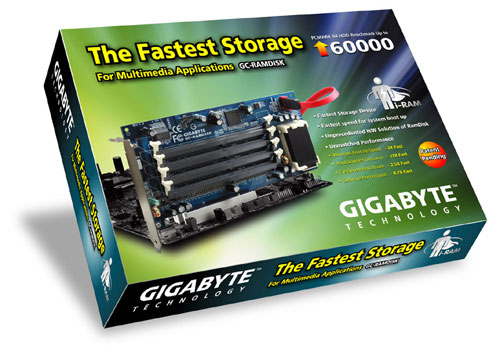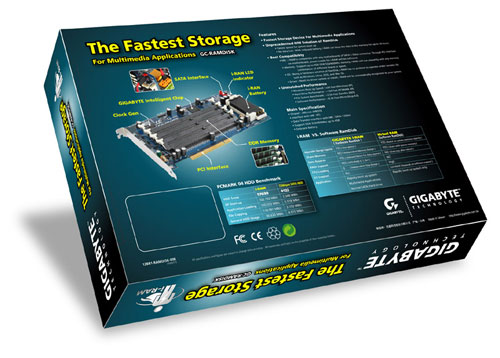Gigabyte's i-RAM: Affordable Solid State Storage
by Anand Lal Shimpi on July 25, 2005 3:50 PM EST- Posted in
- Storage
For years now, motherboard manufacturers have been struggling to find other markets to branch out to, in an attempt to diversify themselves, preparing for inevitable consolidation in the market. Every year at Computex, we'd hear more and more about how the motherboard business was getting tougher and we'd see more and more non-motherboard products from these manufacturers. For the most part, the non-motherboard products weren't anything special. Everyone went into making servers, then multimedia products, then cases, networking, security, water cooling; the list goes on and on.
This year's Computex wasn't very different, except for one thing. When Gigabyte showed us their collection of goodies for the new year, we were actually quite interested in one of them. And after we posted an article about it, we found that quite a few of you were very interested in it too. Gigabyte's i-RAM was an immediate success and it wasn't so much that the product was a success, but it was the idea that piqued everyone's interests.
Pretty much every time a faster CPU is released, we always hear from a group of users who are marveled by the rate at which CPUs get faster, but loathe the sluggish rate that storage evolves. We've been stuck with hard disks for decades now, and although the thought of eventually migrating to solid state storage has always been there, it's always been so very distant. These days, you can easily get a multi-gigabyte solid state drive if you're willing to spend the tens of thousands of dollars it costs to get one; prices actually vary from the low $1000s to the $100K range for solid state devices, obviously making them impractical for desktop users.
The performance benefits of solid state storage have always been tempting. With no moving parts, reliability is improved tremendously, and at the same time, random accesses are no longer limited by slow and difficult to position read/write heads. While sequential transfer rates have improved tremendously over the past 5 years, thanks to ever increasing platter densities among other improvements, it is the incredibly high latency that makes random accesses very expensive from a performance standpoint for conventional hard disks. A huge reduction in random access latency and increase in peak bandwidth are clear performance advantages to solid state storage, but until now, they both came at a very high price.
The other issue with solid state storage is that DRAM is volatile, meaning that as soon as power is removed from the drive, all of your data would be lost. More expensive solutions get around this by using a combination of a battery backup as well as a hard disk that keeps a backup of all data written to the solid state drive, just in case the battery or main power should fail.
Recognizing the allure of solid state storage, especially to performance-conscious enthusiast users, Gigabyte went about creating the first affordable solid state storage device, and they called it i-RAM.
Through some custom logic, the i-RAM works and acts just like a regular SATA hard drive. But how much of a performance increase is there for desktop users? And is the i-RAM worth its still fairly high cost of entry? We've spent the past week trying to find out...
This year's Computex wasn't very different, except for one thing. When Gigabyte showed us their collection of goodies for the new year, we were actually quite interested in one of them. And after we posted an article about it, we found that quite a few of you were very interested in it too. Gigabyte's i-RAM was an immediate success and it wasn't so much that the product was a success, but it was the idea that piqued everyone's interests.
Pretty much every time a faster CPU is released, we always hear from a group of users who are marveled by the rate at which CPUs get faster, but loathe the sluggish rate that storage evolves. We've been stuck with hard disks for decades now, and although the thought of eventually migrating to solid state storage has always been there, it's always been so very distant. These days, you can easily get a multi-gigabyte solid state drive if you're willing to spend the tens of thousands of dollars it costs to get one; prices actually vary from the low $1000s to the $100K range for solid state devices, obviously making them impractical for desktop users.
The performance benefits of solid state storage have always been tempting. With no moving parts, reliability is improved tremendously, and at the same time, random accesses are no longer limited by slow and difficult to position read/write heads. While sequential transfer rates have improved tremendously over the past 5 years, thanks to ever increasing platter densities among other improvements, it is the incredibly high latency that makes random accesses very expensive from a performance standpoint for conventional hard disks. A huge reduction in random access latency and increase in peak bandwidth are clear performance advantages to solid state storage, but until now, they both came at a very high price.
The other issue with solid state storage is that DRAM is volatile, meaning that as soon as power is removed from the drive, all of your data would be lost. More expensive solutions get around this by using a combination of a battery backup as well as a hard disk that keeps a backup of all data written to the solid state drive, just in case the battery or main power should fail.
Recognizing the allure of solid state storage, especially to performance-conscious enthusiast users, Gigabyte went about creating the first affordable solid state storage device, and they called it i-RAM.



Through some custom logic, the i-RAM works and acts just like a regular SATA hard drive. But how much of a performance increase is there for desktop users? And is the i-RAM worth its still fairly high cost of entry? We've spent the past week trying to find out...










133 Comments
View All Comments
crazySOB297 - Monday, July 25, 2005 - link
I'm surprised they didn't raid a few of them... I think you could get some huge performance.Googer - Tuesday, July 26, 2005 - link
Not to mention it is a way to also get around the 4gb siza limitation.
Hacp - Monday, July 25, 2005 - link
Dude the article said straight out that SATA150 was the only format supported. Read the entire article.Guspaz - Monday, July 25, 2005 - link
I too am dissapointed that the article lacked any mention of SATA2, which is twice as fast as SATA (300MB/s vs 150MB/s). Considering many motherboards already on the market suport SATA2, and the 300MB/s transfer rate that goes with it, it is a bit of an oversight that the articles doesn't even MENTION if the card supports SATA2 or not. Nor do they mention what they think would happen with SATA2, or if Gigabyte is likely to produce a SATA2 version. It's a weak spot in this article, I think, considering how central the bandwidth of SATA is to the performance of the i-RAM.snorbert - Tuesday, July 26, 2005 - link
33MHz PCI only gets you 133 MB/sec theoretical, and more like 110 MB/sec in the real world. The i-RAM with SATA 1 can completely saturate a PCI bus. SATA2 would cost more to implement, and give you no speed increase at all on a 33MHz bus. If you build the card for higher-end PCI specs (e.g. 66MHz, 64 bit, 66MHz/64bit, PCI-X) then you automatically exclude most PC enthusiasts (unless they like buying server boards for their game boxes).
If they end up doing a PCI Express version, then there would be some reason to support SATA2.
This board is not a replacement for a hard drive. It would be incredibly useful as a transaction log though. Reliable (i.e. won't get lost if the machine crashes) write-behind caching for RAID 5 drives will give you a huge boost to write speeds. And the controller cards that support battery-backed write behind caching cost a lot more money than an i-RAM.
-Jason
sprockkets - Tuesday, July 26, 2005 - link
Also to reply hereKeep in mind that for many years the ide/sata controllers are NOT on the PCI bus of the southbridge, so PCI is not a limitation.
snorbert - Tuesday, July 26, 2005 - link
Actually, scratch my comment - I had not had enough coffee when I wrote it. I forgot that the PCI connector is doing essentially squat except providing power to this device. Of course you could have a SATA2 controller on a faster bus talking to this thing. But an SATA2 version would probably cost more. (because it would need a faster FPGA, newer SATA transceivers)Sorry folks,
Jason the doofus
Anton74 - Monday, July 25, 2005 - link
You did miss that reference; on page 2 it says "The i-RAM currently implements the SATA150 spec, giving it a maximum transfer rate of 150MB/s".Given the 1.6GB/s of the RAM, it seems completely silly not to provide a 300MB/s SATA interface instead, especially considering that the whole contraption including RAM will cost as much as 2 or more decent hard drives.
Anton
ryanv12 - Monday, July 25, 2005 - link
The controller on the card is not SATA-II...it can do a max of 1.6GB/s...not exactly SATA-II speeds there...Anton74 - Monday, July 25, 2005 - link
1.6GB/s is actually more than 5 times 300MB/s, the maximum supported by SATA-II. So 300MB/s could easily be fully utilized, and I don't understand why they didn't support that.Anton